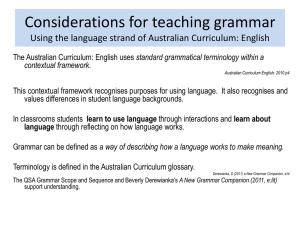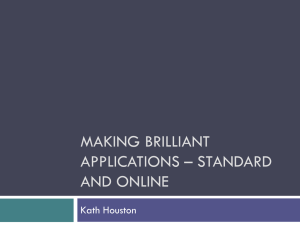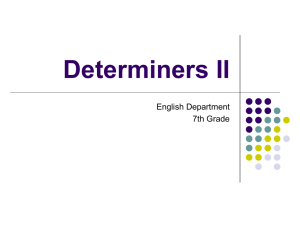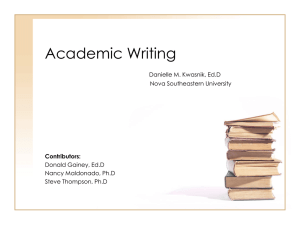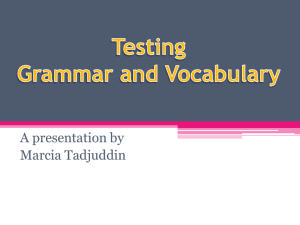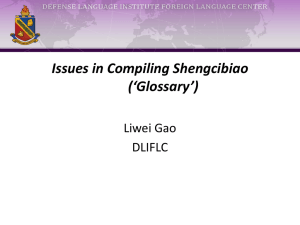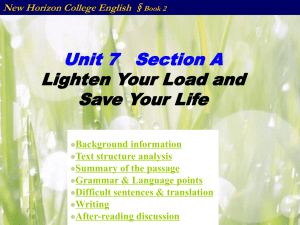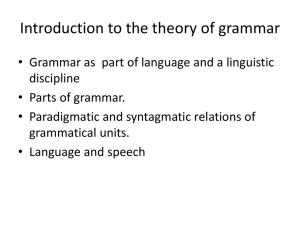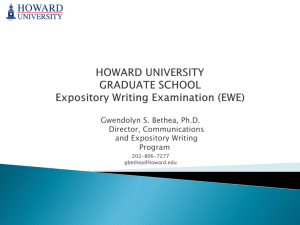File
advertisement
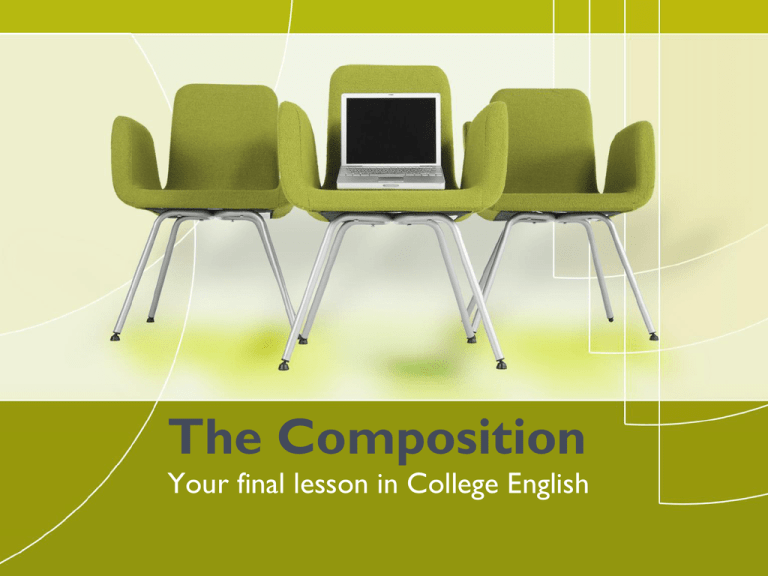
The Composition Your final lesson in College English What we will learn A. Pre-writing strategies B. Traditional Forms of Discourse C.Revision strategies A. Pre-writing strategies The Composition 1. Brainstorming 2. Clustering/Idea mapping 3. Free writing 4. Journal writing B. Traditional forms of discourse 1. Narration (telling the story of events) 1.1 Telling a story 1.2 Relating series of events chronologically 1.3 Narrating fictional or nonfictional events 1.4 Giving directions, instructions, advice (writer's motives) 1.5 Focusing on the self B. Traditional forms of discourse 2. Description (describing people, places and objects) 2.1 Telling what things are like 2.2 Using nouns, adjectives to portray something 2.3 Visualizing characters, settings, actions 2.4 Evoking mood, atmosphere through simile, metaphor 2.5 Clarifying confusion; correcting misconceptions; setting record straight (writer's motive) 2.6 Focusing on the self B. Traditional forms of discourse 3. Exposition (explaining; sharing information or ideas) 3.1 Writing to inform 3.2 Using information for readers to see, understand 3.3 Noting logic of explanation 3.4 Noting logic of description 3.5 Citing subtypes 3.6 Bearing witness; registering a grievance (writer's motive) 3.7 Focusing on reality B. Traditional forms of discourse 4. Argumentative (convincing by appealing to emotions or shared values) 4.1 Convincing through logic 4.2 Presenting explicitly author's opinion or "thesis" 4.3 Building a case to support thesis 4.4 Presenting reasons and evidence supporting reasons 4.5 Reporting events; sharing data; arguing a position (writer's motive) 4.6 Focusing on the audience Paragraphs written in the traditional forms of discourse EXAMPLES Narration Almost every detail of that night stands out very clearly in memory. I even remember the name of the movie we saw because its title impressed me as being so patly ironical. It was a movie about the German occupation of France, starring Maureen O'Hara and Charles Laughton and called "This Land Is Mine." I remember the name of the diner we walked into when the movie ended: it was the "American Diner." When we walked in the counterman asked what we wanted and I remember answering with the casual sharpness which had become my habit: "We want a hamburger and a cup of coffee, what do you think we wnat?" I do not know why, after a year of such rebuffs, I so completely failed to anticipate his answer, which was, of course, "We don't serve Negroes here." This reply failed to discompose me, at least at the moment. I made some sardonic comment about the name of the diner and we walked out into the streets. --James Baldwin, "Notes of a Native Son" Description Clouds are streaming off the ocean, and the metal legs of the tripod are cold against my hands as I set up the spotting scope. I'm out for birds, and the lagoon is thick with them. Grebes and canvasbacks, buffleheads and mergansers work the shallow water for fish, and coots honk and dodge like little black taxicabs in the reeds along the shore. Across the lagoon, a great blue heron flaps and glides along the shoreline, scouting a likely feeding station. Its thin, improbable legs trail out behind -- tools of the trade, in tow from one fishing spot to the next. It lands now, gracefully, delicately for a bird the height of a six-year-old child. Herons are all stilts and feathers and this old giant -- which looks as if it could wrap its wings around a Honda -- is likely no heavier than a wailing human newborn. Fiddling with the scope until the bird fills my vision, I find it transfixed, surveying the shallows for frogs or cruising fish. William E. Poole, "For the Birds,” SAN FRANCISCO CHRONICLE Exposition The importation of plants is the primary agent in the modern spread of species, for animals have almost invariably gone along with the plants, quarantine being a comparatively recent and not completely effective innovation. The United States Office of Plant Introduction alone has introduced almost 200,000 species and varieties of plants from all over the world. Nearly half of the 180 or so major insect enemies of plants in the United States are accidental imports from abroad, and most of them have come as hitchhikers on plants. In new territory, out of reach of the restraining hand of the natural enemies that kept down its numbers in its native land, an invading plant or animal is able to become enormously abundant. Thus it is no accident that our most troublesome insects are introduced species. Rachel Carson, "Silent Spring" Argumentative In a recent year, 65 percent of the murders, 63 percent of the robberies, and 24 percent of the aggravated assaults involved guns. A government commission found that parts of the country with the highest level of gun ownership have the highest incidence of gun-related violence. When stronger gun control laws are enacted, robberies and homicides tend to decrease. When Massachusetts enacted a stricter gun control law, homicides decreased an unbelievable 55 percent during the two following years. Our rate of violent crimes is 100 percent higher than that of Great Britain, which has stricter gun control laws, and it is 200 percent higher than that of Japan, which outlaws private ownership of handguns. All the available evidence shows that the easy availability of handguns in this country is one of the main causes of violent crime. C. REVISION STRATEGIES Revising the Draft - entails looking at your paper with a “fresh pair of eyes” Revising for content – re-examining the supporting evidence you’ve provided in order to explore or explain your topic. Revising for content : Arguments and Ideas Revision Checklist 1. What is the thesis of the paper? 2. What supporting evidence, i.e., facts, examples and illustrations, are provided? 3. Are these pieces of supporting evidence sufficient? 4. Are they adequately and logically explained? 5. Is information obtained from scholarly sources used correctly, and cited accurately and completely? 6. Is the organization logical? Revising for language and style – allows you to make your paper more “readable”, i.e., showing few errors in word choice, spelling, grammar, and sentence structure Revising for content : Language Revision Checklist: Words 1. Did you use specific words instead of general ones? 2. Did you consider both the connotative and denotative meaning of the words you used? 3. Did you use formal language? 4. Did you use non-sexist language? A CEO of a certain company decides to use grammar as the litmus test for his decision whether or not to hire an employee. Here’s why. I Won't Hire People Who Use Poor Grammar. Here's Why. by Kyle Wiens If you think an apostrophe was one of the 12 disciples of Jesus, you will never work for me. If you think a semicolon is a regular colon with an identity crisis, I will not hire you. If you scatter commas into a sentence with all the discrimination of a shotgun, you might make it to the foyer before we politely escort you from the building. Some might call my approach to grammar extreme, but I prefer Lynne Truss's more cuddly phraseology: I am a grammar "stickler." And, like Truss — author of Eats, Shoots & Leaves — I have a "zero tolerance approach" to grammar mistakes that make people look stupid. Now, Truss and I disagree on what it means to have "zero tolerance." She thinks that people who mix up their itses "deserve to be struck by lightning, hacked up on the spot and buried in an unmarked grave," while I just think they deserve to be passed over for a job — even if they are otherwise qualified for the position. Everyone who applies for a position at either of my companies, iFixit or Dozuki, takes a mandatory grammar test. Extenuating circumstances aside (dyslexia, English language learners, etc.), if job hopefuls can't distinguish between "to" and "too," their applications go into the bin. Of course, we write for a living. iFixit.com is the world's largest online repair manual, and Dozuki helps companies write their own technical documentation, like paperless work instructions and step-by-step user manuals. So, it makes sense that we've made a preemptive strike against groan-worthy grammar errors. But grammar is relevant for all companies. Yes, language is constantly changing, but that doesn't make grammar unimportant. Good grammar is credibility, especially on the internet. In blog posts, on Facebook statuses, in e-mails, and on company websites, your words are all you have. They are a projection of you in your physical absence. And, for better or worse, people judge you if you can't tell the difference between their, there, and they're. Good grammar makes good business sense — and not just when it comes to hiring writers. Writing isn't in the official job description of most people in our office. Still, we give our grammar test to everybody, including our salespeople, our operations staff, and our programmers. On the face of it, my zero tolerance approach to grammar errors might seem a little unfair. After all, grammar has nothing to do with job performance, or creativity, or intelligence, right? Wrong. If it takes someone more than 20 years to notice how to properly use "it's,“ then that's not a learning curve I'm comfortable with. So, even in this hyper-competitive market, I will pass on a great programmer who cannot write. Grammar signifies more than just a person's ability to remember high school English. I've found that people who make fewer mistakes on a grammar test also make fewer mistakes when they are doing something completely unrelated to writing — like stocking shelves or labeling parts. In the same vein, programmers who pay attention to how they construct written language also tend to pay a lot more attention to how they code. You see, at its core, code is prose. Great programmers are more than just code monkeys; according to Stanford programming legend Donald Knuth they are "essayists who work with traditional aesthetic and literary forms.“ The point: programming should be easily understood by real human beings — not just computers. And just like good writing and good grammar, when it comes to programming, the devil's in the details. In fact, when it comes to my whole business, details are everything. I hire people who care about those details. Applicants who don't think writing is important are likely to think lots of other (important) things also aren't important. And I guarantee that even if other companies aren't issuing grammar tests, they pay attention to sloppy mistakes on résumés. After all, sloppy is as sloppy does. That's why I grammar test people who walk in the door looking for a job. Grammar is my litmus test. All applicants say they're detail-oriented; I just make my employees prove it. Revising for Unity – ensures that all your paragraphs help develop the thesis statement and that all sentences in each paragraph talk about one idea or focus. Exercise on revising for unity 1. 2. 3. a. Write the thesis of the paper. Write the topic sentence of each of your paragraphs. Answer the following questions: Do the topic sentences illustrate, clarify, or explain the thesis? b. Which ones do not seem to do that? Try to rewrite or revise these topic sentences. 4. Now read each paragraph, and answer the following questions: a. Do all the sentences in the paragraph illustrate, clarify or explain the topic? b. Which sentences are not directly related to the topic sentence of the paragraph? Omit or revise the sentence. Revising for Coherence - ensures that the information presented in your paper is logically arranged and smoothly linked Exercise on revising for coherence Read one or two paragraphs of your research paper, and then answer the following questions. 1. What is the topic sentence of the paragraph? 2. What details support the topic sentence? 3. What principle of organization was used to organize the paragraph? Is the organization effective? 4. Were transitions and key words used to give variety and coherence? What key terms are repeated or referred to by pronouns? 5. What transitions are used? 6. What (if anything) could be done to make the coherence stronger? Now, do the same steps, this time focusing on the entire paper. Acknowledgement Special thanks to Prof. Lui Recillo and Prof. Shiela Simat for sharing the material and to Prof. Willie Remollo for sharing the Kyle Wiens article. Additional reference: Perfecto, M.R. et al. (2005). The New Anvil Guide to Research Paper Writing. Pasig City: Anvil Publishing, Inc. Template Provided By www.animationfactory.com 500,000 Downloadable PowerPoint Templates, Animated Clip Art, Backgrounds and Videos

